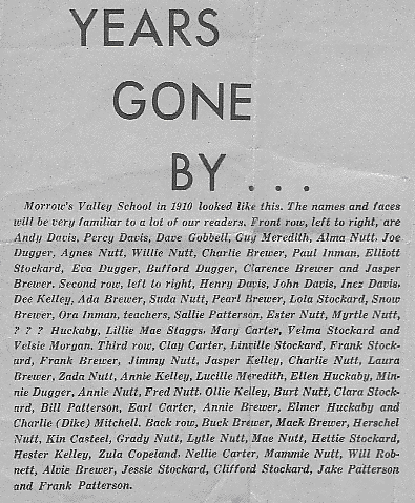Bruce and Julie Teague's Family Site | home
GENEALOGY | KINCAID | William Clingan | Richardson Family | Clingan Kincaid (the 3rd) | Rufus "Mac" Kincaid | Ann Richardson | Kincaid Family Pictures | Williams's Will | Will of Drury Richardson | Dugger Family | Jackson Family | John's (1st) Will | Documents for John Kincaid the 2nd | CW Parole | A History of the 5th Tennessee Cavalry, CSA | Clingan(3) and Family (Circa 1902-03) | Clingan's DC | Dorothy Neoma Gunn | Jack Kincaid | WWI Service Record | TEAGUE | Nathaniel's Louisiana Land Patent | Nathan II Arkansas Land Patent | CEMETERY SURVEY for Teague Relations | Nathaniel Teague's Boys | Rhubert Edwin Teague | Rhubert and Mary Teague | Williamson Family | Andrew's 1860 Land Patent | Mary Williamson Teague | Gildon Family | R. R. Gildon | Williamson Family Pictures | Henry's Obit | Lilla's Obit | Thomas Chipman McRae | Caswell Family | Caswell Pictures | Will of Matthew Caswell II | Will of Matthew Caswell III | CHANDLER | Gann Family | Bible of Amos Chandler | Obit of William L. Chandler | Chandler Pictures | Sutton Family | Hahn Family | Cantiberry, Eubanks, JONES | DICKEY | Obit of Cord L. Dickey | Dickey Pictures | Farmer Family | Edith Farmer
Jackson Family
1-James Jackson b: ca 1780 (NC/SC?), d: ca1833-1838
sp: unknown
2-Andrew Jackson b: 1816, TN, d: 1862, Corinth, MS
sp: Frances Staggs b: 1817, TN, m: 1836, Wayne Co, TN
3-William J. "Bill" Jackson b: 1837, Wayne Co, TN 19th Biffles Tenn. Cav.
3-James Jackson b: 1839, Wayne Co, TN (Confederate, killed at Shiloh, unit unknown as yet)
3-John A. Jackson b: 15 Mar 1843, Wayne Co, TN 22nd Nixons Tenn. Cav.
sp: Martha A. Acklin b: 22 Oct 1847, TN, m: 20 Oct 1865, Wayne Co, TN
4-Ora B. Jackson b: May 1882, Wayne Co, TN
sp: George Dugger, b: Apr 1881, Wayne Co, TN
m: Nov. 1913, Waynesboro, Wayne Co, TN
4-Claiborn Jackson b: 1866, TN
4-Eleander Jackson b: 1870, TN
3-George A. "Saint" Jackson b: 1845, Wayne Co, TN (Confederate, probably Nixons 22nd Cav.)
3-Susannah Jackson b: 1849, Wayne Co, TN
3-David Jackson b: 1851, Wayne Co, TN
3-Jonathan E. Jackson b: 1853, Wayne Co, TN
3-Jacob M. Jackson b: 1856, Wayne Co, TN
2-James Jackson b: 1818, Wayne Co, TN
sp: Malinda, b: 1818, TN
In Other Words . . .
As of January, 2002, I believe my Jacksons came from Surry Co, North Carolina (still in question) to Tennessee sometime between 1811 and 1813. There are some indications they came from South Carolina. About 1816-1817 the Jacksons came to Lawrence County. They came there in the same wave of migration, spurred by the recent acquisition of Indian land, that brought the famous David Crockett to the area--and also my wife's ancestors, the Farmers. By 1820, most of the family had moved again to Wayne County. All eventually settled in an area known as Ashland, on 48 Mile Creek. By 1830 James Jackson, my g-g-g-g-grandfather, had 4 boys and 8 girls living in his house, though I have no knowledge that these are all his. I only know 2 sons for sure: Andrew and James.
Andrew (g-g-g-grandfather), son of James, married Frances "Fanny" Staggs about 1836. Frances was the daughter of Joseph Staggs and Frances Nesbitt. It was probably somewhere around this time that James died, and Andrew took up running the family farm. He bought 193 acres in Wayne County in 1851. In that same year he bought 95 more acres. Around this time Andrew Jackson and Joacum Dugger were friends and neighbors. Descendants of these two men would eventually marry, and beget my grandmother, Sheila Moore Dugger. They both served on several County Court juries in the late 40s and early 50s. Evidently, Andrew prospered. On October 4th, 1852, John Jackson Senior--who may have been an uncle--was granted Administrator's rights for the family of William Staggs, deceased. Andrew put up a $1,000 bond as his security. (Samuel Staggs was already living with John in 1850. According to the census, he was listed as "Idiot." He was 24 years old. More than likely, he was orphaned, and what we would call today, "Mentally Challenged," and therefore required supervision.) In that same year he was appointed guardian of orphans Joseph and Mary Jane Kyle, after securing a bond of $1,500. He became a Justice of the Peace, and performed the marriage of his first born, William J. to Saphrona Jane Surratt.
When the Civil War began, much of Wayne County was against seccession--true Unionist--but Andrew's two oldest boys, William J.and James, enlisted early in the Confederate Army. The exact unit is still being researched, but more thasn likely it was either the 48th Tenn. Inf. or possibly the 2nd Battalion Tenn. Cav. - both raised companies from Wayne County. After the guns were silent at the Shiloh battlefield, Andrew received word that James had been killed and William J.(known as Bill) was wounded, perhaps mortally. Good father that he was, Andrew mounted his horse, and went into the carnage in search of his boys. Four days later, Eli Merriman, friend and neighbor, found Andrew's horse, gun, and saddle, but Andrew was missing. He was presumed dead, and to this day his cause of death is still a mystery.
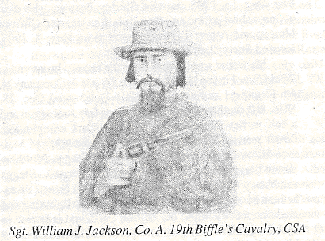
William J. Jackson recovered, and later enlisted in Biffles 19th Tenn. Cavalry. In November of 1863, John A. Jackson and his younger brother George Andrew "Saint", also enlisted in Nixon's 22nd Tenn. Cavalry. This unit was raised by Colonel George H. Nixon after his original command, the 48th Tenn. Infantry, was consolidated with the 35th, under command of Colonel J. B. Hill. Many of the men of Colonel George H. Nixon's 48th Tenn. Infantry were from the Lawrence and Wayne County area. This regiment was decimated after the Battle of Chickamauga, and thus too small to carry on. Colonel Nixon, without a command, was then asked to return to Tennessee and recruit behind enemy lines, a new unit of cavalry. (The 22nd was also known as the 20th.)
In late 1864 General John Bell Hood began his ill-fated invasion of Middle Tennessee. Nixon's regiment was ordered to join the command of Nathaniel Bedford Forrest for that venture. They fought the battle of Spring Hill on November 29th, Franklin on November 30th, and Nashville on December 15th and 16th. Hood was forced to retreat back across the Tennessee River, into Alabama, and Mississippi. As usual, the cavalry served as reaguard. By Christmas of 1864, Nixon's men were on the Hampshire pike, near Columbia, Maury County. At this point, being so near, several of the men wanted to go home and see there families for Christmas. John was particularly anxious as his mother was now widowed, and she still had 4 children under 15 to care for in a land that was very pro Union. John and Lt. John Morris headed home, while the army retreated. At home, John had to hide to avoid being seen by Unionst in the neighborhood. Nevertheless, he was discovered, and just before the new year began, his house was surrounded by Union soldiers. John ran from the house as shots whizzed by him. He ran into some woods, but was soon surrounded and captured.
The soldiers brought him back to his house. His sister Susannah, began packing him some clothes, under the impression that he was a prisoner. To their shock, the officer in command announced that they had evidence that John was a known guerilla and bushwhacker, and therefore would not have need of any clothes. They took him to the home of John Robinett, where he was kept under guard for the night. Robinett happened to be a staunch Union man, and brother-in-law of Joseph Staggs, John's grandfather from his mother's side. During the night other Unionist neighbors came to the house and talked to the soldiers.
The next morning, John was taken down to a creek (48 Mile?) where he thought they were going to execute him. In the mean time, several more neighbors came and pleaded for his life. The Federals then took John back to his house, and offered to spare him if he took the Oath. Seeing the condition his family was in, John took the Oath.
It was now 1865, and John remained at home with his family, tending to what farm there was. After the war, in October of 1865, he married Martha Acklin. So far I have only found 3 of their children in a 16 year span. Evidently, Ora Jackson, my great-grandmother, was their last.
Ora Jackson was married first about 1902 to an Inman, and they had 2 children. He died just before 1910. She married my great-grandfather George Dugger in 1913.
Sources are Wayne County records and the Pension claim of John A. Jackson.
** I wish to thank Ellen Hernandez and Garry Brewer for helping me with the above information.
PICTURES
g-g-Grandmother
Martha Acklin Jackson circa 1920
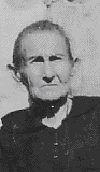
Ora Jackson Inman Dugger Ora as a teacher, with her class--second from left sitting in front
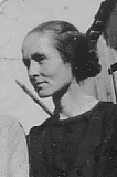
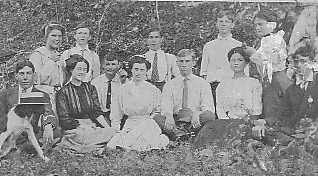
Morrow's Valley School: 1910, from the Wayne County News (Aug 15, 1969)
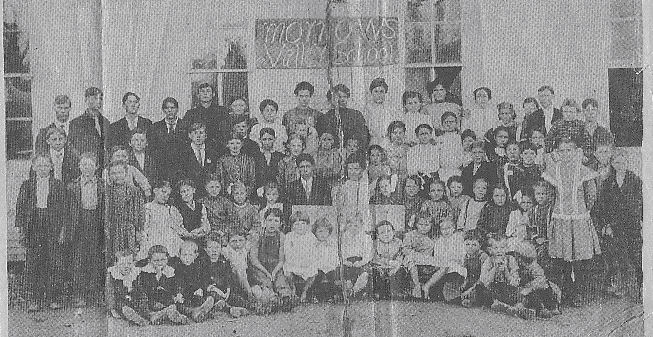
Names
